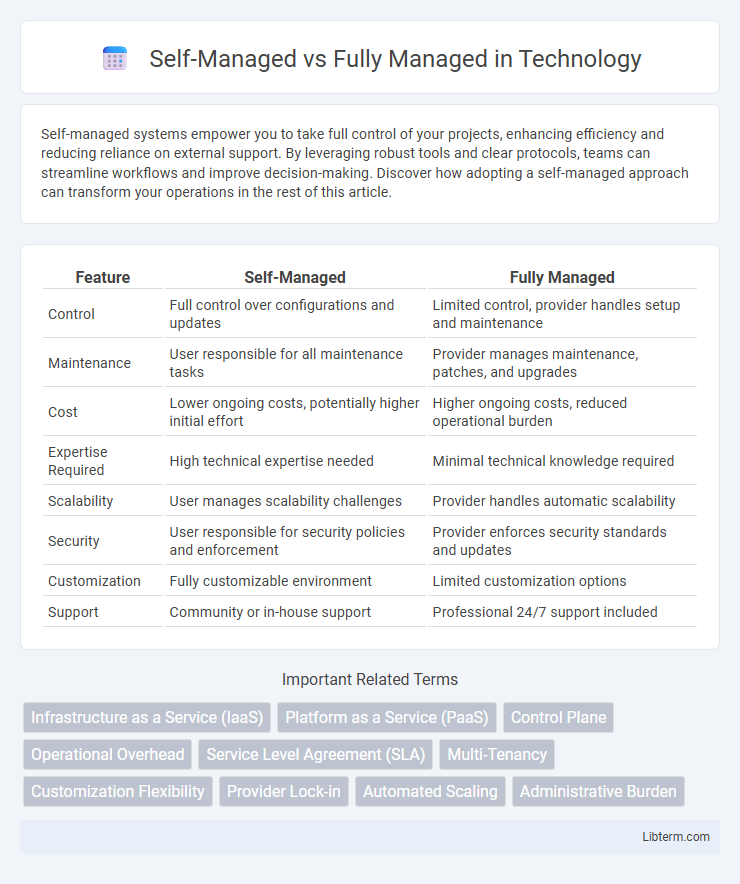Self-managed systems empower you to take full control of your projects, enhancing efficiency and reducing reliance on external support. By leveraging robust tools and clear protocols, teams can streamline workflows and improve decision-making. Discover how adopting a self-managed approach can transform your operations in the rest of this article.
Table of Comparison
| Feature | Self-Managed | Fully Managed |
|---|---|---|
| Control | Full control over configurations and updates | Limited control, provider handles setup and maintenance |
| Maintenance | User responsible for all maintenance tasks | Provider manages maintenance, patches, and upgrades |
| Cost | Lower ongoing costs, potentially higher initial effort | Higher ongoing costs, reduced operational burden |
| Expertise Required | High technical expertise needed | Minimal technical knowledge required |
| Scalability | User manages scalability challenges | Provider handles automatic scalability |
| Security | User responsible for security policies and enforcement | Provider enforces security standards and updates |
| Customization | Fully customizable environment | Limited customization options |
| Support | Community or in-house support | Professional 24/7 support included |
Understanding Self-Managed Services
Self-managed services require businesses to handle installation, configuration, maintenance, and updates independently, offering greater control and customization at the cost of increased responsibility. These services demand in-house technical expertise and ongoing resource allocation to ensure optimal performance and security. Understanding the scope of self-managed solutions is crucial for organizations aiming to tailor infrastructure to specific needs while balancing operational challenges.
Exploring Fully Managed Solutions
Fully managed solutions offer comprehensive support by handling infrastructure, maintenance, security, and updates, enabling businesses to focus on core activities without IT overhead. These services often include 24/7 monitoring, automated backups, and scalable resources tailored to specific workloads and industry compliance requirements. By leveraging fully managed platforms, organizations can reduce downtime, enhance performance, and ensure robust data protection with minimal internal resource allocation.
Key Differences Between Self-Managed and Fully Managed
Self-managed services require users to handle all aspects of configuration, maintenance, and troubleshooting, while fully managed services shift these responsibilities to the provider. In a self-managed environment, users maintain full control and customization but must allocate more time and technical expertise, whereas fully managed solutions offer scalability, security, and support without user intervention. Cost differences often arise, with self-managed options generally incurring lower upfront expenses but higher operational overhead compared to fully managed services that include comprehensive support within their pricing.
Cost Comparison: Self-Managed vs Fully Managed
Self-managed solutions often require higher upfront investments in hardware, software licenses, and dedicated IT staff, leading to increased operational expenses over time. Fully managed services typically involve predictable monthly or annual fees that include maintenance, support, and infrastructure costs, reducing unexpected expenditures. Evaluating total cost of ownership (TCO) over a multi-year period reveals that fully managed options can offer cost savings by minimizing resource allocation and downtime risks.
Control and Customization Levels
Self-managed solutions provide organizations with extensive control and customization, allowing them to tailor systems and configurations to specific needs without dependency on third-party providers. Fully managed services limit direct control, as providers handle maintenance, updates, and infrastructure management, offering ease of use but restricting customization options. Choosing between self-managed and fully managed depends on prioritizing granular control and flexibility versus convenience and reduced operational overhead.
Security and Compliance Considerations
Self-managed solutions require organizations to take full responsibility for security configurations, patch management, and compliance adherence, demanding in-house expertise and constant monitoring to mitigate risks. Fully managed services offer built-in security protocols, automated updates, and compliance certifications like ISO 27001 and GDPR, reducing the operational burden on businesses. Companies handling sensitive data often prefer fully managed options to ensure continuous compliance and robust protection against evolving cyber threats.
Scalability and Performance Factors
Self-managed systems provide granular control over resource allocation, enabling tailored scalability to specific workload demands but require expert management to optimize performance effectively. Fully managed services offer automated scaling and load balancing, ensuring consistent high availability and optimized performance without manual intervention. Choosing between the two depends on the need for customization versus ease of scaling and performance management in dynamic environments.
Support and Maintenance Responsibilities
Self-Managed services require users to handle all support and maintenance tasks, including troubleshooting, updates, security patches, and system backups, demanding technical expertise and dedicated resources. Fully Managed services provide comprehensive support through expert teams who perform routine maintenance, monitor system health, apply security updates, and resolve issues proactively, reducing operational overhead for clients. Choosing between the two depends on desired control levels, in-house skill sets, and willingness to manage ongoing system upkeep.
Use Cases for Self-Managed and Fully Managed
Self-managed solutions are ideal for organizations with in-house expertise seeking full control over infrastructure customization, security configurations, and compliance requirements, common in industries like finance and healthcare. Fully managed services suit businesses prioritizing rapid deployment, operational simplicity, and scalability, often benefiting startups and companies with limited IT resources. Use cases for self-managed include complex, regulatory-driven environments, while fully managed is preferred for standard workloads needing agility and minimized maintenance.
Choosing the Right Approach for Your Business
Choosing between self-managed and fully managed solutions depends on your business's technical expertise, budget, and control requirements. Self-managed options provide greater customization and direct oversight but demand significant in-house resources and expertise. Fully managed services offer ease of use and reduced maintenance burdens, making them ideal for businesses prioritizing scalability and operational simplicity.
Self-Managed Infographic

 libterm.com
libterm.com